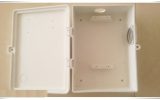House wires are an important part of the “home safety” manual, but they are usually neglected. Most house fires start from an electrical short-circuit, due to faulty house wiring systems. Another cause for this are the out-of-date wiring systems, which are unable to take the load of modern electrical and light appliances. Neglect to defective wiring systems could lead to personal injuries, property damage or even death. Therefore, one should know how to tackle basic house wiring issues and prevent them for a safe home.
- Overlamping
What & How: When a light fixture with a lower wattage is fixed with a bulb that uses higher wattage.
This is a danger sign as the bulb’s heat that melt the fixtures’ wires and insulation system. You’re at risk of arc faults, which is when sparks jump from one wire to another. This could be a potential cause of house fires. Even if you take out the offending bulb, the damage to the light fixture still remains.
What to do: Most modern light fixtures have their wattage rating, therefore stay within the range. For light fixtures older than 1985, buy only 60-watt bulbs.
- Flickering lights when it’s windy
What & How: Frayed wires in the weather head, which causes a short circuit when it’s windy.
There could be many reasons to flickering lights, but you should worry if you’re using an appliance with fluctuating voltage. Check the voltage in your house with a barometer. Moreover, a loose or insecure fixture can also cause housefires.
What to do: Call an electrician if needed and get your house wiring evaluated. You may even need to get your weather head replaced.
- Too few outlets
What & How: Overdependence on extension cords and surge protectors
The dangers are minimal as long as you use heavy-duty extension cords, which may be 14-gauge or thicker. Undersized extension cords may overheat and cause fire if overloaded.
What to do: Read the instructions about the amount of power the extension cord draws. Look for extension cords that can handle the wattage of the specific electrical appliance. Never power multiple appliances with one cord. Moreover, add more outlets for your appliances which will solve much of your problem.
- Aluminum electrical wiring
What & How: Aluminum house wires were used as a substitute for copper in the 1970s, but now can contribute to electrical hazards.
Aluminum wires connections can corrode with copper and loosen connections. They also overheat easily at the connections between wires and devices and cause fires.
What to do: Add a dielectric wire nut approved to the copper/aluminum connections in light fixtures. These nuts are approved for aluminum wires, and stop corrosion while maintaining their conductive abilities. Ensure that the replacement switches and receptacles are aluminum-compatible.
Some Safety Tips
- Be informed about the house wiring decisions you make. You don’t have to be an expert, but do learn the basics of house wiring.
- Choose the right supplier for your purpose. The expert supplier is professional, has high-quality products and gives great after-sale service.
- The importance of high-quality electrical products cannot be stressed enough. Please don’t compromise on your safety for a few dollars.
House wiring is not rocket science, but it’s better to educate yourself. Keep your family as number on the priority list, and select the best products and house wires manufacturers for yourself. By these simple tips, you would be able to solve basic house wiring problems and ensure safety for your family.



















